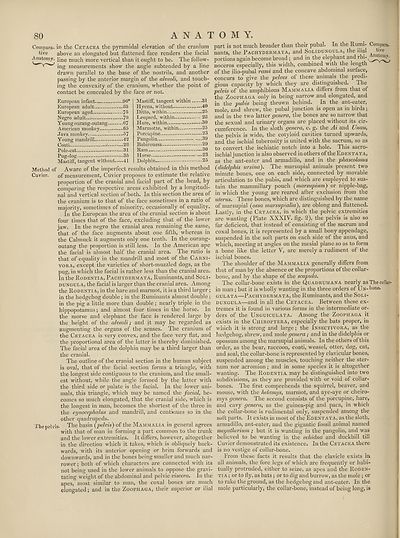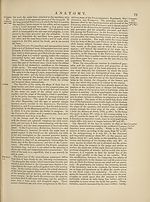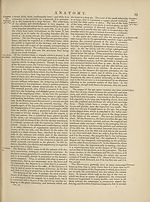Encyclopaedia Britannica > Volume 3, Anatomy-Astronomy
(88) Page 80
Download files
Complete book:
Individual page:
Thumbnail gallery: Grid view | List view

80
ANATOMY.
Compara- in the Cetacea the pyramidal elevation of the cranium part is not much broader than their pubah In the Rumi- Compara-
tive above an elongated but flattened face renders the facial nants, the Pachydermata, and Solidungula, tie 11a
Anatomy. iine much more vertical than it ought to be. The follow- portions again become broad; and in the elephant and rln-
ing measurements show the angle subtended by a line noceros especially, this width, combine^ wit engt
drawn parallel to the base of the nostrils, and another
passing by the anterior margin of the alveoli, and touch¬
ing the convexity of the cranium, whether the point of
contact be concealed by the face or not.
European infant 90*
European adult 05
European aged 75
Negro adult..: 70
Young ourang-outang 67
American monkey 65
Java monkey 57
Young mandrill 42
Coati •' 28
Pole-cat 31
Pug-dog 35
Mastiff^ tangent without 41
Method of Aware of the imperfect results obtained in this method
Cuvier. 0f measurement, Cuvier proposes to estimate the relative
proportion of the cranial and facial part of the head, by
comparing the respective areas exhibited by a longitudi¬
nal and vertical section of both. In this section the area of
the cranium is to that of the face sometimes in a ratio of
majority, sometimes of minority, occasionally of equality.
In the European the area of the cranial section is about
four times that of the face, excluding that of the lower
jaw. In the negro the cranial area remaining the same,
that of the face augments about one fifth, whereas in
the Calmuck it augments only one tenth. In the ourang-
outang the proportion is still less. In the American ape
the facial is almost half the cranial area. The ratio is
that of equality in the mandrill and most of the Carni¬
vora, except the varieties of short-muzzled dogs, as the
pug, in which the facial is rather less than the cranial area.
In the Rodentia, Pachydermata, Ruminants, and Soli¬
dungula, the facial is larger than the cranial area. Among
the Rodentia, in the hare and marmot, it is a third larger ;
in the hedgehog double; in the Ruminants almost double ;
in the pig a little more than double; nearly triple in the
hippopotamus; and almost four times in the horse. In
the morse and elephant the face is rendered large by
the height of the alveoli; and it may be regarded as
augmenting the organs of the senses. The cranium of
the Cetacea is very convex, and the face very flat, and
the proportional area of the latter is thereby diminished.
The facial area of the dolphin may be a third larger than
the cranial.
The outline of the cranial section in the human subject
is oval, that of the facial section forms a triangle, with
the longest side contiguous to the cranium, and the small¬
est without, while the angle formed by the latter with
the third side or palate is the facial. In the lower ani¬
mals, this triangle, which may be named the facial, be¬
comes so much elongated, that the cranial side, which is
the longest in man, becomes the shortest of the three in
the cynocephalm and mandrill, and continues so in the
other quadrupeds.
The pelvis. The basin {pelvis) of the Mammalia in general agrees
with that of man in forming a part common to the trunk
and the lower extremities. It differs, however, altogether
in the direction which it takes, which is obliquely back¬
wards, with its anterior opening or brim forwards and
downwards, and in the bones being smaller and much nar¬
rower ; both of which characters are connected with its
not being used in the lower animals to oppose the gravi¬
tating weight of the abdominal and pelvic viscera. In the
apes, most similar to man, the coxal bones are much
elongated; and in the Zoophaga, their superior or ilial
of the ilio-pubal rami and the concave abdominal surface,
concurs to give the pelves of these animals the prodi¬
gious capacity by which they are distinguished. 1 he
pelvis of the amphibious Mammalia differs from that of
the Zoophaga only in being narrow and elongated, and
Mastiff, tangent within 31 in the pubis being thrown behind. In the ant-eater,
Ka;=^:=::25 mole, and shrew, the pubal junction is open as in birds;
Leopard, within 28 and in the two latter genera, the bones are so narrow that
Hare, within 30 the sexual and urinary organs are placed without its cir-
Marmotte, within 25 cumference. In the sloth genera, e. g. the Ai and Unau,
Porcupine 23 ^ pejvjs js wide, the cotyloid cavities turned upwards,
Pangolin. 39 ^ tbe ischial tuberosity is united with the sacrum, so as
R:in~::::::::::::::::::::::30 to convert the isclnatic notch into a hole. This sacro-
Horse.V......... 23 ischial junction is also observed in others of the Edentata,
Dolphin 25 as the ant-eater and armadillo, and in the phascoloma
The marsupial animals present two
(didelphis ursina).
minute bones, one on each side, connected by movable
articulation to the pubis, and which are employed to sus¬
tain the mammillary pouch (marsupium) or nipple-bag,
in which the young are reared after exclusion from the
uterus. These bones, which are distinguished by the name
of marsupial {ossa marsupialia), are oblong and flattened.
Lastly, in the Cetacea, in which the pelvic extremities
are wanting (Plate XXXIV. fig. 2), the pelvis is also so
far deficient, that instead of consisting of the sacrum and
coxal bones, it is represented by a small bony appendage,
suspended in the soft parts on each side of the anus, and
which, meeting at angles on the mesial plane so as to form
a bone like the letter V, are merely a rudiment of the
ischial bones.
The shoulder of the Mammalia generally differs from
that of man by the absence or the proportions of the collar¬
bone, and by the shape of the scapula.
The collar-bone exists in the Quadrumana nearly as The collar-
in man; but it is wholly wanting in the three orders of Un- bone.
gulata—Pachydermata, the Ruminants, and the Soli¬
dungula—and in all the Cetacea. Betw'een these ex¬
tremes it is found in various forms in the intermediate or¬
ders of the Unguiculata. Among the Zoophaga it
exists in the Chiroptera, especially the bats proper, in
which it is strong and large; the Insectivora, as the
hedgehog, shrew, and mole genera; and in the didelphis or
opossum among the marsupial animals. In the others of this
order, as the bear, raccoon, coati, weasel, otter, dog, cat,
and seal, the collar-bone is represented by clavicular bones,
suspended among the muscles, touching neither the ster¬
num nor acromion; and in some species it is altogether
wanting. The Rodentia may be distinguished into two
subdivisions, as they are provided with or void of collar¬
bones. The first comprehends the squirrel, beaver, and
mouse, with the helamys, marmot, and aye-aye or cheiro-
mys genera. The second consists of the porcupine, hare,
and cavy genera, as the guinea-pig and paca, in which
the collar-bone is rudimental only, suspended among the
soft parts. It exists in most of the Edentata, as the sloth,
armadillo, ant-eater, and the gigantic fossil animal named
megatherium ; but it is wanting in the pangolin, and was
believed to be wanting in the echidna and duckbill till
Cuvier demonstrated its existence. In the Cetacea there
is no vestige of collar-bone.
From these facts it results that the clavicle exists in
all animals, the fore legs of which are frequently or habi¬
tually protruded, either to seize, as apes and the Roden¬
tia ; or to fly, as bats ; or to dig and burrow, as the mole; or
to rake the ground, as the hedgehog and ant-eater. In the
mole particularly, the collar-bone, instead of being long, is
ANATOMY.
Compara- in the Cetacea the pyramidal elevation of the cranium part is not much broader than their pubah In the Rumi- Compara-
tive above an elongated but flattened face renders the facial nants, the Pachydermata, and Solidungula, tie 11a
Anatomy. iine much more vertical than it ought to be. The follow- portions again become broad; and in the elephant and rln-
ing measurements show the angle subtended by a line noceros especially, this width, combine^ wit engt
drawn parallel to the base of the nostrils, and another
passing by the anterior margin of the alveoli, and touch¬
ing the convexity of the cranium, whether the point of
contact be concealed by the face or not.
European infant 90*
European adult 05
European aged 75
Negro adult..: 70
Young ourang-outang 67
American monkey 65
Java monkey 57
Young mandrill 42
Coati •' 28
Pole-cat 31
Pug-dog 35
Mastiff^ tangent without 41
Method of Aware of the imperfect results obtained in this method
Cuvier. 0f measurement, Cuvier proposes to estimate the relative
proportion of the cranial and facial part of the head, by
comparing the respective areas exhibited by a longitudi¬
nal and vertical section of both. In this section the area of
the cranium is to that of the face sometimes in a ratio of
majority, sometimes of minority, occasionally of equality.
In the European the area of the cranial section is about
four times that of the face, excluding that of the lower
jaw. In the negro the cranial area remaining the same,
that of the face augments about one fifth, whereas in
the Calmuck it augments only one tenth. In the ourang-
outang the proportion is still less. In the American ape
the facial is almost half the cranial area. The ratio is
that of equality in the mandrill and most of the Carni¬
vora, except the varieties of short-muzzled dogs, as the
pug, in which the facial is rather less than the cranial area.
In the Rodentia, Pachydermata, Ruminants, and Soli¬
dungula, the facial is larger than the cranial area. Among
the Rodentia, in the hare and marmot, it is a third larger ;
in the hedgehog double; in the Ruminants almost double ;
in the pig a little more than double; nearly triple in the
hippopotamus; and almost four times in the horse. In
the morse and elephant the face is rendered large by
the height of the alveoli; and it may be regarded as
augmenting the organs of the senses. The cranium of
the Cetacea is very convex, and the face very flat, and
the proportional area of the latter is thereby diminished.
The facial area of the dolphin may be a third larger than
the cranial.
The outline of the cranial section in the human subject
is oval, that of the facial section forms a triangle, with
the longest side contiguous to the cranium, and the small¬
est without, while the angle formed by the latter with
the third side or palate is the facial. In the lower ani¬
mals, this triangle, which may be named the facial, be¬
comes so much elongated, that the cranial side, which is
the longest in man, becomes the shortest of the three in
the cynocephalm and mandrill, and continues so in the
other quadrupeds.
The pelvis. The basin {pelvis) of the Mammalia in general agrees
with that of man in forming a part common to the trunk
and the lower extremities. It differs, however, altogether
in the direction which it takes, which is obliquely back¬
wards, with its anterior opening or brim forwards and
downwards, and in the bones being smaller and much nar¬
rower ; both of which characters are connected with its
not being used in the lower animals to oppose the gravi¬
tating weight of the abdominal and pelvic viscera. In the
apes, most similar to man, the coxal bones are much
elongated; and in the Zoophaga, their superior or ilial
of the ilio-pubal rami and the concave abdominal surface,
concurs to give the pelves of these animals the prodi¬
gious capacity by which they are distinguished. 1 he
pelvis of the amphibious Mammalia differs from that of
the Zoophaga only in being narrow and elongated, and
Mastiff, tangent within 31 in the pubis being thrown behind. In the ant-eater,
Ka;=^:=::25 mole, and shrew, the pubal junction is open as in birds;
Leopard, within 28 and in the two latter genera, the bones are so narrow that
Hare, within 30 the sexual and urinary organs are placed without its cir-
Marmotte, within 25 cumference. In the sloth genera, e. g. the Ai and Unau,
Porcupine 23 ^ pejvjs js wide, the cotyloid cavities turned upwards,
Pangolin. 39 ^ tbe ischial tuberosity is united with the sacrum, so as
R:in~::::::::::::::::::::::30 to convert the isclnatic notch into a hole. This sacro-
Horse.V......... 23 ischial junction is also observed in others of the Edentata,
Dolphin 25 as the ant-eater and armadillo, and in the phascoloma
The marsupial animals present two
(didelphis ursina).
minute bones, one on each side, connected by movable
articulation to the pubis, and which are employed to sus¬
tain the mammillary pouch (marsupium) or nipple-bag,
in which the young are reared after exclusion from the
uterus. These bones, which are distinguished by the name
of marsupial {ossa marsupialia), are oblong and flattened.
Lastly, in the Cetacea, in which the pelvic extremities
are wanting (Plate XXXIV. fig. 2), the pelvis is also so
far deficient, that instead of consisting of the sacrum and
coxal bones, it is represented by a small bony appendage,
suspended in the soft parts on each side of the anus, and
which, meeting at angles on the mesial plane so as to form
a bone like the letter V, are merely a rudiment of the
ischial bones.
The shoulder of the Mammalia generally differs from
that of man by the absence or the proportions of the collar¬
bone, and by the shape of the scapula.
The collar-bone exists in the Quadrumana nearly as The collar-
in man; but it is wholly wanting in the three orders of Un- bone.
gulata—Pachydermata, the Ruminants, and the Soli¬
dungula—and in all the Cetacea. Betw'een these ex¬
tremes it is found in various forms in the intermediate or¬
ders of the Unguiculata. Among the Zoophaga it
exists in the Chiroptera, especially the bats proper, in
which it is strong and large; the Insectivora, as the
hedgehog, shrew, and mole genera; and in the didelphis or
opossum among the marsupial animals. In the others of this
order, as the bear, raccoon, coati, weasel, otter, dog, cat,
and seal, the collar-bone is represented by clavicular bones,
suspended among the muscles, touching neither the ster¬
num nor acromion; and in some species it is altogether
wanting. The Rodentia may be distinguished into two
subdivisions, as they are provided with or void of collar¬
bones. The first comprehends the squirrel, beaver, and
mouse, with the helamys, marmot, and aye-aye or cheiro-
mys genera. The second consists of the porcupine, hare,
and cavy genera, as the guinea-pig and paca, in which
the collar-bone is rudimental only, suspended among the
soft parts. It exists in most of the Edentata, as the sloth,
armadillo, ant-eater, and the gigantic fossil animal named
megatherium ; but it is wanting in the pangolin, and was
believed to be wanting in the echidna and duckbill till
Cuvier demonstrated its existence. In the Cetacea there
is no vestige of collar-bone.
From these facts it results that the clavicle exists in
all animals, the fore legs of which are frequently or habi¬
tually protruded, either to seize, as apes and the Roden¬
tia ; or to fly, as bats ; or to dig and burrow, as the mole; or
to rake the ground, as the hedgehog and ant-eater. In the
mole particularly, the collar-bone, instead of being long, is
Set display mode to:
![]() Universal Viewer |
Universal Viewer | ![]() Mirador |
Large image | Transcription
Mirador |
Large image | Transcription
Images and transcriptions on this page, including medium image downloads, may be used under the Creative Commons Attribution 4.0 International Licence unless otherwise stated. ![]()
| Encyclopaedia Britannica > Encyclopaedia Britannica > Volume 3, Anatomy-Astronomy > (88) Page 80 |
|---|
| Permanent URL | https://digital.nls.uk/193758492 |
|---|
| Attribution and copyright: |
|
|---|---|
| Shelfmark | EB.16 |
|---|---|
| Description | Ten editions of 'Encyclopaedia Britannica', issued from 1768-1903, in 231 volumes. Originally issued in 100 weekly parts (3 volumes) between 1768 and 1771 by publishers: Colin Macfarquhar and Andrew Bell (Edinburgh); editor: William Smellie: engraver: Andrew Bell. Expanded editions in the 19th century featured more volumes and contributions from leading experts in their fields. Managed and published in Edinburgh up to the 9th edition (25 volumes, from 1875-1889); the 10th edition (1902-1903) re-issued the 9th edition, with 11 supplementary volumes. |
|---|---|
| Additional NLS resources: |
|

